Bell & Ross
Introducing the Bell & Ross x The Rake and Revolution Bellytanker “El Mirage” and “Dusty” Chronographs
Bell & Ross
Introducing the Bell & Ross x The Rake and Revolution Bellytanker “El Mirage” and “Dusty” Chronographs
Bell & Ross was born out of the vivid imagination and single vision of two of the nicest men in the Swiss watchmaking industry, Bruno Belamich and Carlos Rosillo. “We knew each other at school and we immediately got on,” says Rosillo. “Bruno was only in Paris for one year and then his family moved back to Burgundy. But one year was enough to know that we were destined to work together.” Their paths crossed again after Belamich had graduated from design school and Rosillo had finished his business degree and had worked for some years in finance. Together they envisioned a watch brand based on the military- and aviation-style watches that had captured their imagination since childhood.
In 1992, they started Bell & Ross with a $20,000 investment. Initially they collaborated with Sinn, who fabricated their watches for them during these early years. The brand made big news in 1997 when it created the Hydromax, a liquid-filled quartz watch that descended to 11,000 metres below sea level. The buzz they generated brought suitors and that same year Chanel made a strategic investment in the brand.

One half of the dynamic duo that heads up Bell & Ross, Bruno Belamich

The other half of the dynamic duo that heads up Bell & Ross, Carlos Rosillo

The Bell & Ross Hydromax (Image: Antiquorum)
Flying High
In 2002, they were able to build their own manufacture and gain valuable autonomy from Sinn. Constantly inspired by aviation, in 2005 the brand unveiled a square watch based on cockpit aviation instruments called the BR-01. The watch has since become one of the most recognisable designs in modern horology and has been extrapolated into versions ranging from a very cool and functional diving watch, to a sapphire crystal-cased flying tourbillon.
I got to know Belamich and Rosillo around 2004, by which time the Hydromax had already become something of a cult collector’s watch. I owned one and wanted to meet the innovators behind it. Despite being a complete Basel neophyte, they greeted me warmly and took the time to guide me through their collection. That, as Bogart says to Claude Rains at the end of Casablanca, was the beginning of a beautiful friendship. Because I cannot think of two men who better embody the perfect balance between creativity and drive, but also the unique capacity to pause and appreciate the beauty of lives that have been blessed by a great deal of success along the way.

In 2015, the square-cased BR01 celebrated its 10th anniversary with a faithful reissue of the 2005 original in a limited run of 500 pieces
In 2017, Bell & Ross designed another Vintage Collection timepiece that I sincerely feel is one of the best modern watchmaking achievements. It is called the Bellytanker Chronograph, and I love it. There are essentially two sports chronographs that very rightly dominate modern watchmaking: the Omega Speedmaster and the Rolex Daytona. Their links to the conquest of human history, with Omega’s certification by NASA and the Daytona’s link to Paul Newman, are unassailable. The designs for these 20th-century icons, while totally different, are both tri-compax perfection in execution. So much so that it is almost impossible to think of any modern sports chronograph, in any price category that is, from a visual perspective, as appealing as either of these.
Up with the Best

The Bell & Ross 2017 Bellytanker Chronograph
But the point is the Bellytanker is both a highly accessibly-priced chronograph and a fantastic design achievement in its own right. And, most importantly, it is charmingly original and devoid of imitation. So how did Bell & Ross come up with its super-cool style? “As with all our prequels in the Vintage Collection, it began with rooting and contextualising the watch in a certain period,” said Belamich. “And we’ve always been big fans of the late-1940s and early-1950s. We also love Americana and, in particular, the post-Second World War hot-rod culture in Southern California.”
OK, so what’s a belly tank? Essentially, it is a detachable fuel tank fitted to the exterior of military aircraft to give them additional reach for long-range missions during the Second World War. After use, they could be jettisoned. After the war, many southern Californian hot-rodders repurposed these tanks to build sleek, slipstream-friendly racing machines.
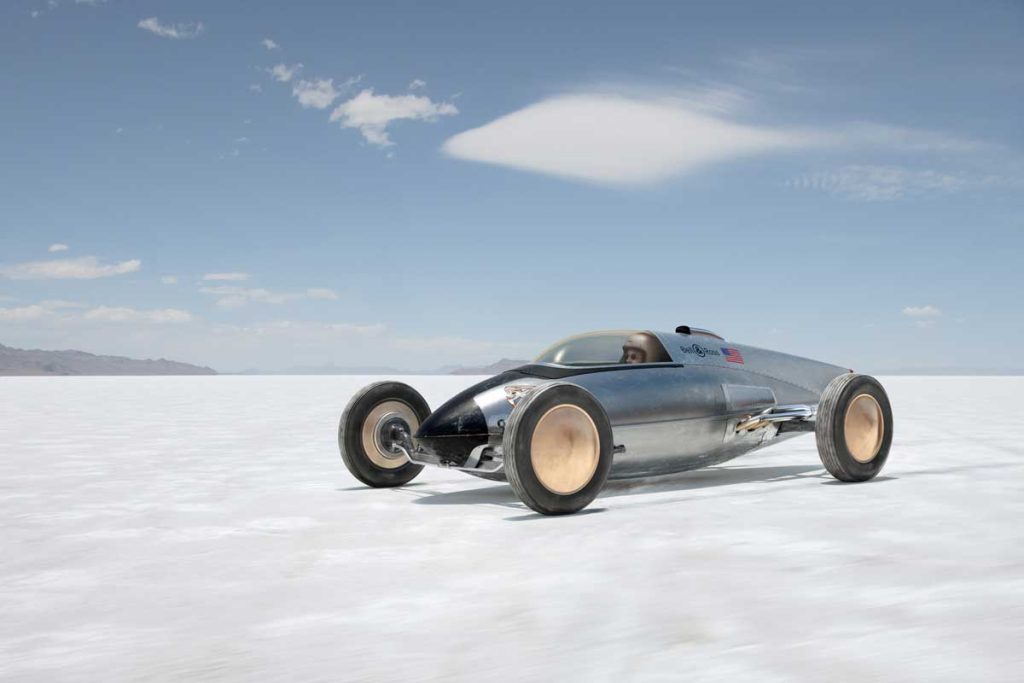
Bell & Ross' own belly tank racer out on the salt flats
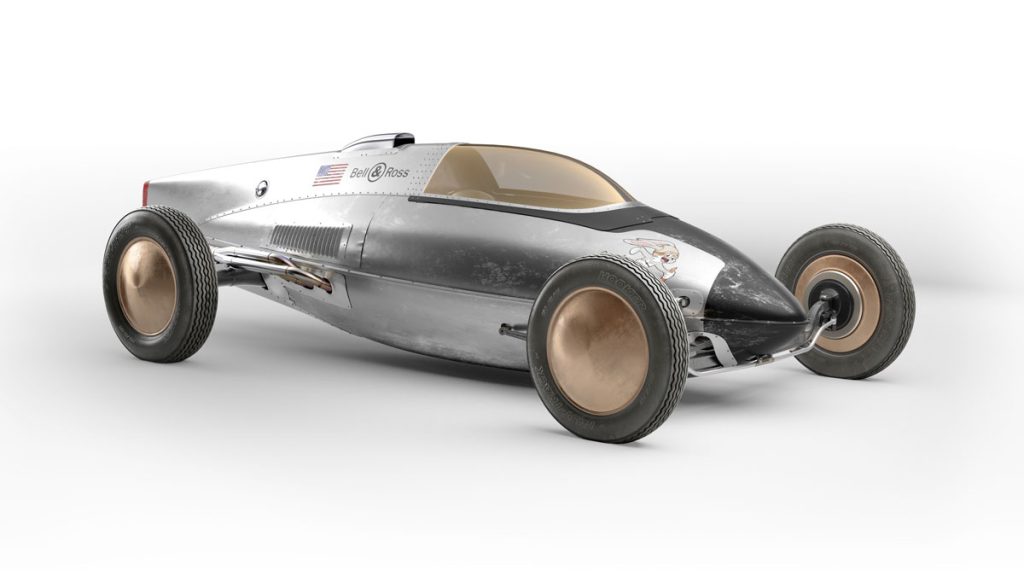
Bell & Ross' own belly tank racer out on the salt flats
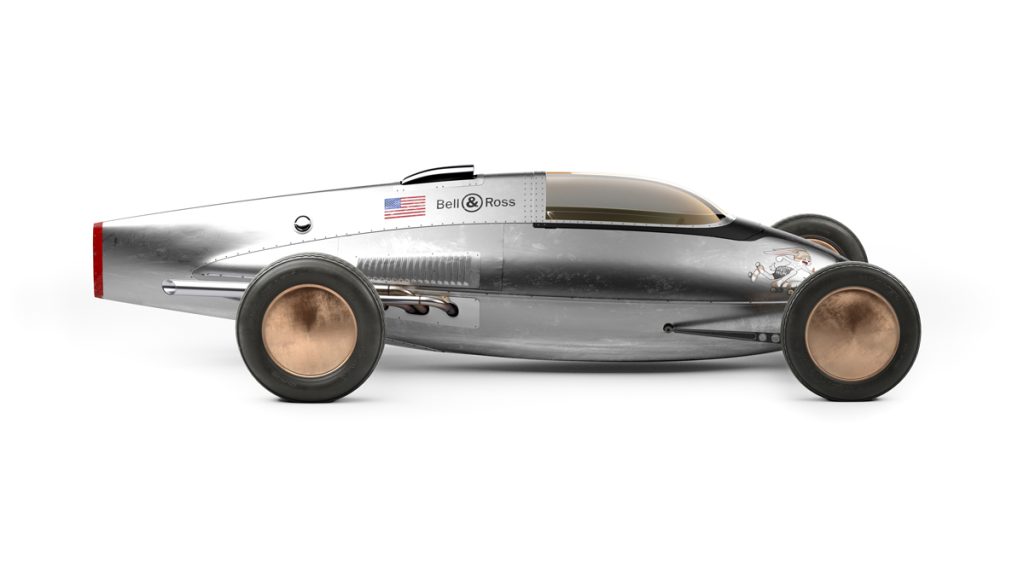
Bell & Ross' own belly tank racer out on the salt flats
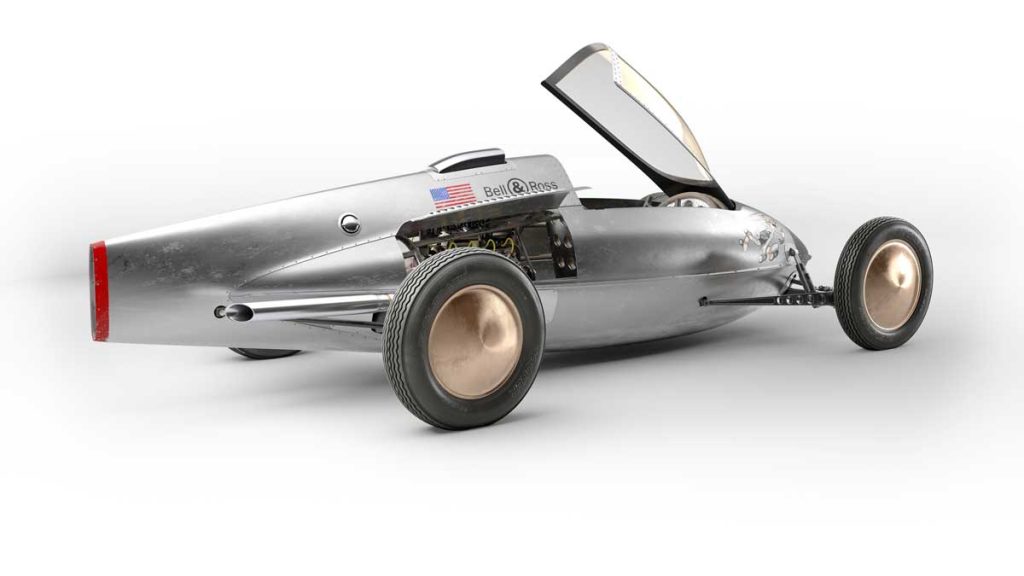
Bell & Ross' own belly tank racer out on the salt flats
Belamich began toying with the idea of what kind of watch the men racing these machines would wear and this gave him the first concepts for the Bellytanker Chronograph. “I wanted to create a chronograph that had some military and aviation codes, in particular super high legibility even at the intense vibrations of the cockpit or when racing, and at the same time had the charm of a de-commissioned military watch that soldiers took with them into civilian life afterwards because they were so attached to them.
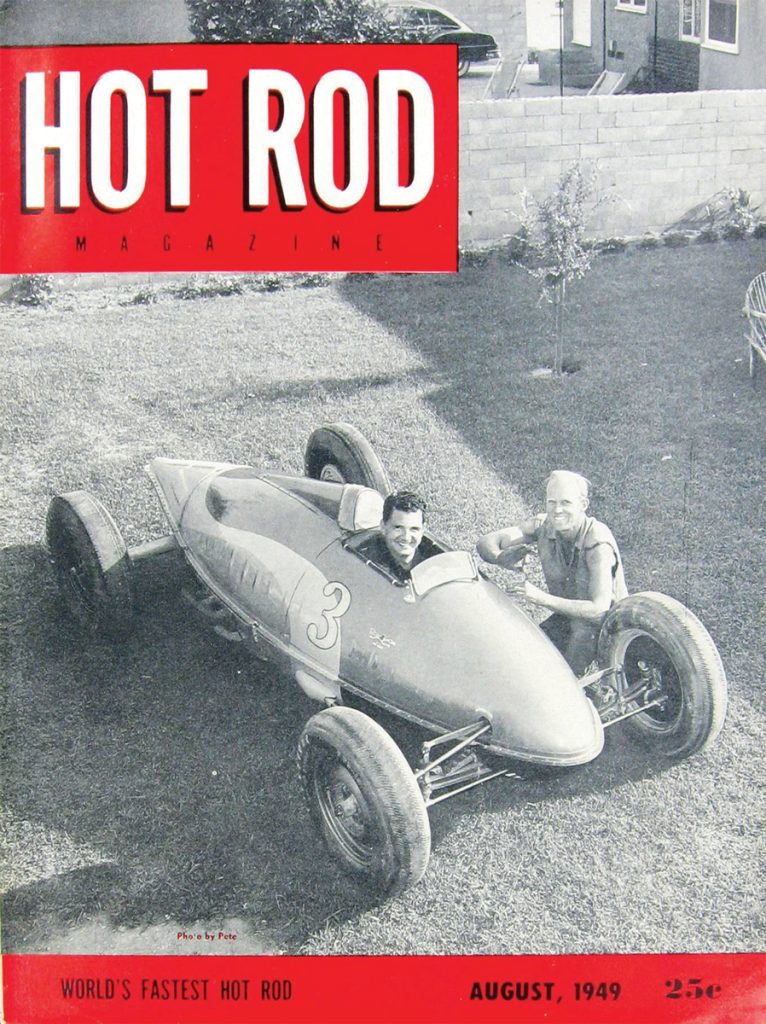
Bill Burke and fellow hot-rodder Don Francisco pose with one of the original belly tanks on the cover of the August 1949 issue of Hot Rod magazine (Image: Hot Rod Magazine)
Dialling It In
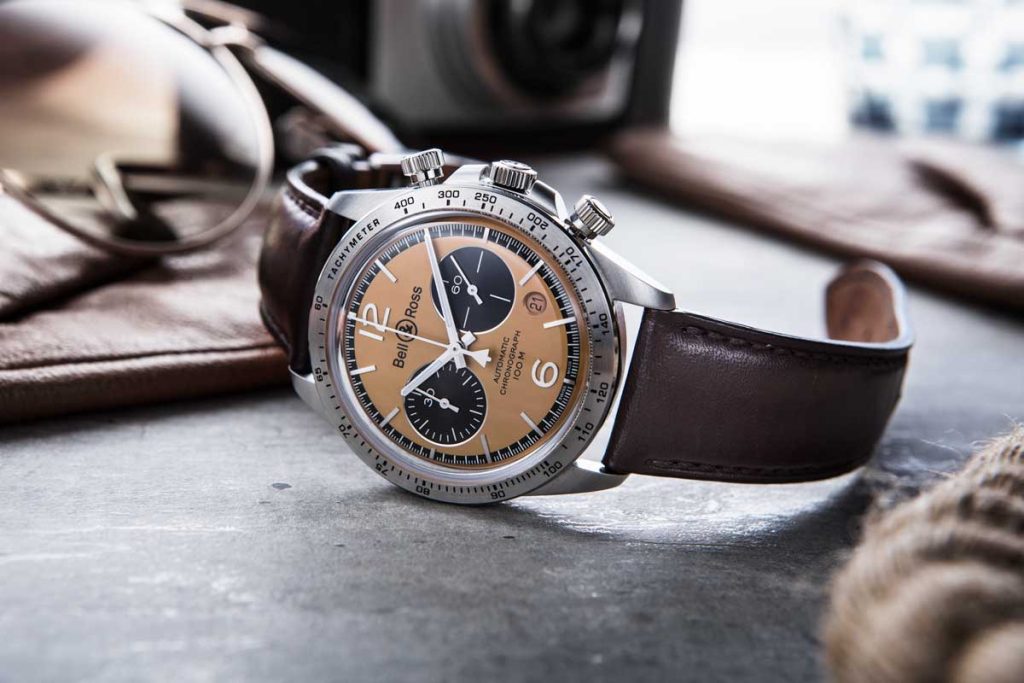
BR V2-94 Bellytanker with brown calfskin strap (© Revolution)
My favourite touch is how the achingly thin brushed-steel hour indexes travel from the inner part of the dial all the way through the step. Compared to a lot of modern sports watches – and certainly those using Valjoux 7750 movements – the case of the Bellytanker, which houses a modular Sellita SW 300, is appealingly lean. The lugs of the case are similarly thin and refined, and the alloy bezel features very cool vintage style typography. Providing the retro street cred of a vintage acrylic but with no compromise in scratch resistance is the domed sapphire crystal. Finally, the screw-pushers and the screw-down crown are all nice, pragmatic touches executed with finesse and taste.
One day, Rosillo, Belamich and I started discussing what it would be like if these watches had been around in the 1950s during the height of the belly tank racing scene and we managed to find one still intact today, perhaps worn on the wrist of Bill Burke while racing, which he then passed down from one generation to the next, the watch worn in his various adventures as a California hot-rod legend. What would that watch look like, we wondered? We loved the idea that the dial of this watch had been affected by UV light of the Southern California sun and the intense heat of the driver’s position inside his race cars, so that it had changed from black to a rich intense tropical brown, not unlike that of the medio tiempo leaves in the cigars favoured by the three of us, resulting in a masterpiece of patina. So, what would this watch – which would essentially be the prequel to the prequel – look like?
Rosillo, Belamich and I began to discuss the current fascination with patina. Maybe it’s because we fear ourselves being hooked up to Matrix-like human battery towers in the near future. But in an age where technology has taken over every dimension of our lives, and our relationships and experiences exist as much in the artificially simulated realm as they do in the corporeal, it seems like there’s never been a time when we were more enchanted with the past. And it is, in particular, patina that has us more charmed than ever.
Growing Old Gracefully

In stabilised bronze, the Bell & Ross x The Rake and Revolution Bellytanker Chronograph “El Mirage” (© Revolution)
But, over the past decade, that’s all changed and there is nothing that we love more than a “barn find,” a car with seats cracked and bodywork evincing a swirling ombre sfumato of naturally occurring age spots. And, in the world of vintage watch collecting, there is nothing more coveted than the “tropical” dial. These are dials that typically began their life as black but then, as a result of strong UV exposure combined with being put away in a dark place afterwards, the upper level of the dial’s lacquer changed anywhere from dark chocolate – as frequently seen on Mk 2 thin case Sea-Dwellers or 145.022-69 Speedmasters – to even lighter amber colours found on a host of different models from various brands.

The Bell & Ross x The Rake and Revolution Bellytanker “Dusty” Chronograph (© Revolution)
“What is beautiful about watches with tropical dials is that each and every one is unique, and I think that this is what collectors find charming about them,” Bacs says. “But the result of the world’s focus on these types of dials is the now massive premium associated with them.” This raises the issue of how to place a watch with an accessible price point with the same emotional and visual effect of a tropical watch in the hands of a younger collector, or on the wrist of someone that doesn’t wish to part with a king’s ransom for one.
The Bell & Ross x The Rake and Revolution Bellytanker “Dusty” Chronograph
We began toying around with the design to create the ultimate aged Bell & Ross Bellytanker Chronograph. But first we had to discuss the moral issue related to creating patina. We knew for example that in last year’s Concorso d’Eleganza at Villa d’Este, a Bentley Blower formerly owned by George Daniels and raced by Tim Birkin was looked at unfavourably because the new owner had decided to re-patina the car himself in a shocking act of sacrilege. But this we decided was a very different exercise.
Rosillo said: “Let’s design the watches precisely as we would imagine them looking after close to 70 years. Let’s select all the exact colour tones and create what we love the most but being totally open about the fact that this is an evocative design exercise.”
The other thing that to me stood us in good stead was that a watch with a tropical dial is essentially a one-of-a-kind collector’s item with a dial that is unstable and still ageing and not something I would wear on a daily basis and not while engaging in sports, traveling extensively or on a motorcycle. I said: “Let’s create our ultimate tropical-inspired watches but that people can wear in any situation – on a boat, even water skiing without worrying about their timepiece.”

The Bell & Ross x The Rake and Revolution Bellytanker “Dusty” Chronograph (© Revolution)

The Bell & Ross x The Rake and Revolution Bellytanker “Dusty” Chronograph (© Revolution)

The Bell & Ross x The Rake and Revolution Bellytanker “Dusty” Chronograph (© Revolution)

The Bell & Ross x The Rake and Revolution Bellytanker “Dusty” Chronograph (© Revolution)
The Bell & Ross x The Rake and Revolution Bellytanker Chronograph “El Mirage”
Our second watch, “El Mirage”, speaks of my penchant for vintage yellow-gold. Amusingly, the flashpoint of inspiration came from the bright yellow livery of Burke’s legendary Belly Tank racer crafted from the tank of the P-51 Mustang.

In stabilised bronze, the Bell & Ross x The Rake and Revolution Bellytanker Chronograph “El Mirage” (© Revolution)
Rosillo explained: “We wanted our collaboration with Revolution and The Rake to be the first time we introduced an all-new material, a type of stabilised bronze.” This is not the first use of this alloy, also used by Tudor for the Black Bay Bronze, but the first time Bell & Ross has introduced the material to its collection.
Belamich said: “Vintage yellow gold from the 1950s has a very specific look to it. We thought we could come close to this hue using stabilised bronze, which we’ve gone to great lengths to ensure will patinate only to a limited extent and, in so doing, will only enhance the whole idea of a vintage watch. This was combined with a champagne dial and tropical brown sub-dials, minute track and bezel to result in what I think is simply magical.”

In stabilised bronze, the Bell & Ross x The Rake and Revolution Bellytanker Chronograph “El Mirage” (© Revolution)

In stabilised bronze, the Bell & Ross x The Rake and Revolution Bellytanker Chronograph “El Mirage” (© Revolution)
Both the Dusty and El Mirage are collaborations with Revolution and The Rake. The idea of the ultimate tropical-themed chronographs resonated well with The Rake team. From a sartorial perspective, there has never been a time where brown suiting in flannels, tweeds, checks, corduroy and even for use in dinner jackets has been more relevant and elegant. And, for those of you with a penchant for the colour brown, we’ve assembled a matching array of sartorial finery at therake.com, which you can pair with either of these watches.
Finally – and most importantly – Rosillo, Belamich and I mutually agreed to keep the price of these alluring timepieces as close to the price of the regular production watches as possible as a thank you and gesture of goodwill to our readers. Just 100 pieces will be made of each version.










